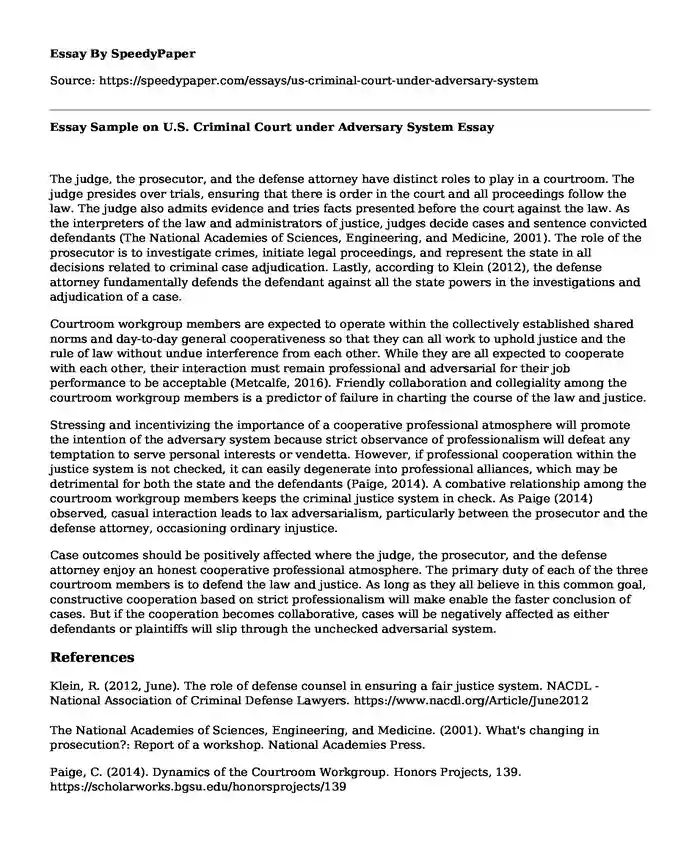
| Type of paper: | Essay |
| Categories: | Criminal law Court system Judicial system Criminal justice |
| Pages: | 2 |
| Wordcount: | 468 words |
The judge, the prosecutor, and the defense attorney have distinct roles to play in a courtroom. The judge presides over trials, ensuring that there is order in the court and all proceedings follow the law. The judge also admits evidence and tries facts presented before the court against the law. As the interpreters of the law and administrators of justice, judges decide cases and sentence convicted defendants (The National Academies of Sciences, Engineering, and Medicine, 2001). The role of the prosecutor is to investigate crimes, initiate legal proceedings, and represent the state in all decisions related to criminal case adjudication. Lastly, according to Klein (2012), the defense attorney fundamentally defends the defendant against all the state powers in the investigations and adjudication of a case.
Courtroom workgroup members are expected to operate within the collectively established shared norms and day-to-day general cooperativeness so that they can all work to uphold justice and the rule of law without undue interference from each other. While they are all expected to cooperate with each other, their interaction must remain professional and adversarial for their job performance to be acceptable (Metcalfe, 2016). Friendly collaboration and collegiality among the courtroom workgroup members is a predictor of failure in charting the course of the law and justice.
Stressing and incentivizing the importance of a cooperative professional atmosphere will promote the intention of the adversary system because strict observance of professionalism will defeat any temptation to serve personal interests or vendetta. However, if professional cooperation within the justice system is not checked, it can easily degenerate into professional alliances, which may be detrimental for both the state and the defendants (Paige, 2014). A combative relationship among the courtroom workgroup members keeps the criminal justice system in check. As Paige (2014) observed, casual interaction leads to lax adversarialism, particularly between the prosecutor and the defense attorney, occasioning ordinary injustice.
Case outcomes should be positively affected where the judge, the prosecutor, and the defense attorney enjoy an honest cooperative professional atmosphere. The primary duty of each of the three courtroom members is to defend the law and justice. As long as they all believe in this common goal, constructive cooperation based on strict professionalism will make enable the faster conclusion of cases. But if the cooperation becomes collaborative, cases will be negatively affected as either defendants or plaintiffs will slip through the unchecked adversarial system.
References
Klein, R. (2012, June). The role of defense counsel in ensuring a fair justice system. NACDL - National Association of Criminal Defense Lawyers. https://www.nacdl.org/Article/June2012
The National Academies of Sciences, Engineering, and Medicine. (2001). What's changing in prosecution?: Report of a workshop. National Academies Press.
Paige, C. (2014). Dynamics of the Courtroom Workgroup. Honors Projects, 139.
https://scholarworks.bgsu.edu/honorsprojects/139
Chretien, P. (2014). Dynamics of the Courtroom Workgroup.
Cite this page
Essay Sample on U.S. Criminal Court under Adversary System. (2023, Oct 09). Retrieved from https://speedypaper.net/essays/us-criminal-court-under-adversary-system
Request Removal
If you are the original author of this essay and no longer wish to have it published on the SpeedyPaper website, please click below to request its removal:
- Free Essay on Marijuana Addiction in Youths
- Free Essay for Everyone: Capabilities Approach
- Essay Sample on Real Estate Disclosure Laws
- Free Essay. Return of the Devil's Son by Big L and Criminal Justice System
- Paper Example. People V. Cunningham.
- Free Essay: Eichmann in Jerusalem
- Free paper Sample on Unraveling Fraud: Legal Implications, Remedies, and the Pursuit of Fairness
Popular categories




